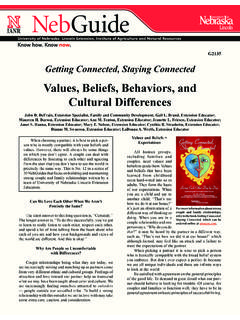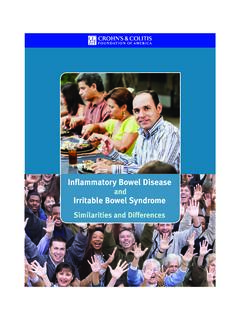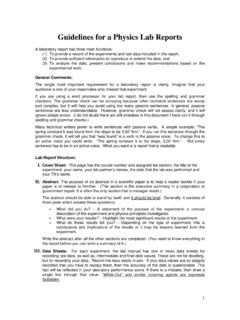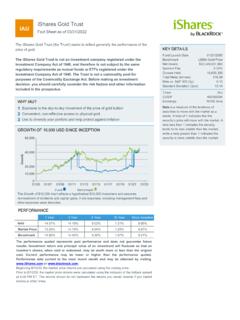Transcription of Differences, and Examples Correlation vs Causation ...
1 2/11/2019 Correlation vs Causation : Definition, differences , & Examples | vs Causation : Definition, differences , and ExamplesLionel ValdellonJuly 24, 2018As mobile marketers, we make decisions every day based on data. These decisions leadusers to keep using our apps or uninstall them. Which is why we have to think clearly whenfacing data and watch out when seeing possible Correlation vs Causation s been a steady move in the past decade for organizations to favor data-drivendecisions. It s the thinking that, without evidence, there s no real basis for a decision. Thismakes it even more critical to use statistics as a tool that gives insight into the relationshipsbetween factors in a given analysis.
2 Statistics helps you differentiate the correlations fromthe vs Causation ExampleMy mother-in-law recently complained to me: Whenever I try to text message, my phonefreezes. A quick look at her smartphone confirmed my suspicion: she had five game appsopen at the same time plus Facebook and YouTube. The act of trying to send a textmessage wasn t causing the freeze, the lack of RAM was. But she immediately connectedit with the last action she was doing before the was implying a Causation where there was only a vs Causation : Definition, differences , & Examples | Correlation and Causation Examples in Mobile MarketingCorrelations are everywhere. As conspiracy theory debunkers like to say: If you look longenough, you ll see patterns.
3 In the same way, if you look long enough, you may begin to see cause-and-effectrelationships in your mobile marketing data where there is only Correlation . We try to find areason why A and B occur at the same if you can spot which is which in these Correlation and Causation Examples below:New web design implemented >> Web page traffic increased Was the traffic increase because of the new design (causality)? Or was traffic simplyup organically at the time when the new design was released ( Correlation )?Uploaded new app store images >> Downloads increased by 2X Did downloads increase because of the new images in your app stores? Or did theyjust happen to occur at the same time?
4 Push notification sent every Friday >> Uninstalls increase every Friday Are people uninstalling your app because of your weekly push notifications? Or issome other factor at play?Increase in links to your website >> Higher ranking in search engine results Does the increase in links directly cause the better search ranking? Or are they merelycorrelated?To better understand Correlation vs Causation , let s begin by defining vs Causation : Definition, differences , & Examples | Art of Onboarding Mobile App UsersMake a great first impression for lasting customer how to onboard users for your app using WhitepaperWhat is Correlation ? Correlation is a term in statistics that refers to the degree of association between tworandom variables.
5 So the Correlation between two data sets is the amount to which theyresemble one A and B tend to be observed at the same time, you re pointing out a Correlation betweenA and B. You re not implying A causes B or vice versa. You re simply saying when A isobserved, B is observed. They move together or show up at the same are three types of correlations that we can identify:Positive Correlation is when you observe A increasing and B increases as well. Or ifA decreases, B correspondingly decreases. Example: the more purchases made inyour app, the more time is spent using your Correlation is when an increase in A leads to a decrease in B or vice Correlation is when two variables are completely unrelated and a change in Aleads to no changes in B, or vice remember: Correlation doesn t imply Causation .
6 It can sometimes be a if you don t believe me, there is a humorous website full of such coincidences calledSpurious Correlations. Here s an example: 12/11/2019 Correlation vs Causation : Definition, differences , & Examples | is Causation ? Causation is implying that A and B have a cause-and-effect relationship with one re saying A causes is also known as , Causation means that two events appear at the same time or one after secondly, it means these two variables not only appear together, the existence ofone causes the other to vs. Causation : Why The Difference MattersKnowing the difference between Correlation and Causation can make a huge difference especially when you re basing a decision on something that may be , you re wondering whether the last month s increase in monthly active users has beencaused by the recent App Store optimization efforts, it makes sense to test this in order tosay for sure whether it s a Correlation or a vs Causation : How to Tell if Something s a Coincidenceor a CausalitySo how do you test your data so you can make bulletproof claims about Causation ?
7 Thereare five ways to go about this technically they are called design of experiments. We listthem from the most robust method to the weakest:1. Randomized and Experimental StudySay you want to test the new shopping cart in your ecommerce app. Your hypothesis isthat there are too many steps before a user can actually check out and pay for their item,and that this difficulty is the friction point that blocks them from buying more often. Soyou ve rebuilt the shopping cart in your app and want to see if this will increase thechances of users buying stuff.**2/11/2019 Correlation vs Causation : Definition, differences , & Examples | The best way to prove Causation is to set up a randomized experiment.
8 This is where yourandomly assign people to test the experimental experimental design, there is a control group and an experimental group, both withidentical conditions but with one independent variable being tested. By assigning peoplerandomly to test the experimental group, you avoid experimental bias, where certainoutcomes are favored over our example, you would randomly assign users to test the new shopping cart you veprototyped in your app, while the control group would be assigned to use the current (old)shopping the testing period, look at the data and see if the new cart leads to more purchases. Ifit does, you can claim a true causal relationship: your old cart was hindering users frommaking a purchase.
9 The results will have the most validity to both internal stakeholdersand other people outside your organization whom you choose to share it with, preciselybecause of the vs Causation : Definition, differences , & Examples | 2. Quasi-Experimental StudyBut what happens when you can t randomize the process of selecting users to take thestudy? This is a quasi-experimental design. There are six types of quasi-experimentaldesigns, each with various applications. The problem with this method is, without randomization, statistical tests becomemeaningless. You cannot be totally sure the results are due to the variable or to nuisancevariables brought about by the absence of studies will typically require more advanced statistical procedures toget the necessary insight.
10 Researchers may use surveys, interviews, and observationalnotes as well all complicating the data analysis s say you re testing whether the user experience in your latest app version is lessconfusing than the old UX. And you re specifically using your closed group of app betatesters. The beta test group wasn t randomly selected since they all raised their hand togain access to the latest features. So, proving Correlation vs Causation or in thisexample, UX causing confusion isn t as straightforward as when using a randomexperimental scientists may shun the results from these studies as unreliable, the data you gathermay still give you useful insight (think trends).3.





